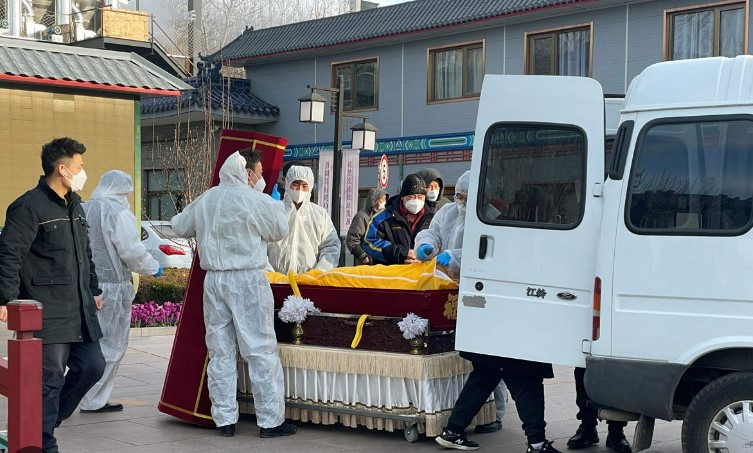Virendra Pandit
New Delhi: As China’s budget deficit hit a record low of USD 1.1 trillion this year because of the Zero Covid slump, the world’s second-largest economy is now headed to face its worst-ever year in decades—experts have warned of three killer waves of the highly-infectious Omicron’s B.7 variant in the next three months that could infect and kill millions.
In other countries, which gradually reopened in 2021 and 2022, a large number of exposed people developed natural immunity and then got better vaccination. Not so in China where the Zero Covid policy kept millions of unvaccinated people confined to homes for three years. They could neither develop natural immunity nor got better vaccines. This is the basic reason for the fresh explosion of the pandemic in an ill-prepared China, three years after other countries faced similar situations.
The widespread lockdowns, testing, and quarantine rules, key to the Zero Covid policy, were abruptly scrapped on December 7. It flooded hospitals and crematoria and also suddenly put an enormous strain on consumer and business spending, pushing the economy close to a contraction in the second quarter of 2023, the media reported on Wednesday.
As bodies of the dead piled up in crematoria and hospitals overflowed with patients in the last two weeks, China’s health system all but collapsed, even in Beijing. Hospitals ran out of beds and medicines and even health officials got infected.
Helpless, the government has thrown up its hands—“those who want to get infected, will get infected, and those who want to die, will die,” was how an official was quoted as saying—and almost lost control over the pandemic management, the reports said. No details from rural areas are available.
Now, epidemiologists predict at least three waves of the coronavirus to hit the country during the three months of ongoing winter. The Chinese government was “under-prepared” when it scrapped the Zero-Covid policy abruptly after people protested across the country, The Hong Kong Post reported.
As it did ever since the outbreak of Covid-19 in early 2020, the Chinese government has so far remained silent on the number of deaths. However, officials have warned of successive waves of infections in the coming months, particularly around the Chinese Lunar New Year on Sunday, January 22, 2023, when millions of people travel to their hometowns and visit tourist places to celebrate this biggest traditional festival of China.
Wu Zunyou, the chief epidemiologist at the Chinese Centre for Disease Control and Prevention, said “the current outbreak would peak this winter and run in three waves for about three months,” The Hong Kong Post reported, citing his press conference in Beijing.
“The first wave started after December 7 and would run until mid-January. A second wave would likely follow soon after, triggered by the mass travel of hundreds of millions of people across the country for the Lunar New Year starting on January 22.”
He predicted that China will also face a “third wave from late February to mid-March after people returned to work from their holidays.”
A large number of people reported countless cases of Covid-19 around them, despite the official count being nearly 2,000 a day. Last week, the National Health Commission admitted that it was “impossible” to keep track of asymptomatic infections and that it would no longer count them. Moreover, the government has decided that only those dying directly of Covid-19-triggered respiratory problems, and not those dying of comorbidities and other diseases worsening because of the pandemic impact, will be counted as pandemic deaths.
Experts have predicted a huge number of deaths—one to two million–in the coming months. They said China is poorly prepared for a drastic exit from the Zero Covid strategy as the country is facing a shortage of strengthening the elderly vaccination rate, intensive care capacity in hospitals, and stockpiling antiviral medications.
According to the projections by three professors at the University of Hong Kong, a nationwide reopening could lead to up to 684 deaths per million people under the current conditions. As China has a population of 1.4 billion people, it would amount to 964,400 deaths.
The increase in Covid-19 cases will “likely overload many local health systems across the country,” The Hong Kong Post reported, citing a research paper released last week on the Medrxiv preprint server, but is yet to be peer-reviewed.
A sudden lifting of Zero-Covid restrictions in all provinces resulted in hospital demands shooting up to two-and-a-half times capacity which could have been avoided with the timely import of better vaccines and giving booster shots and antiviral drugs to the elderly and vulnerable people.
If the fourth-dose vaccination covers 85 percent and antiviral coverage reaches 60 percent, the death count can be lowered by 26 to 35 percent, the study, which is funded partly by the Chinese Center for Disease Control and Prevention (CDC) and the Hong Kong government, said.
With the panicked people suddenly clueless, city streets appeared haunted over the last weekend in Beijing and Shanghai despite the easing of restrictions. As infections surged, the Xi Jinping-led government is facing crucial questions, such as what the government was doing other than locking people in homes and conducting mass testing, and why could it not import better vaccines and equipment.
The media reported that China’s own vaccines did not prove as effective as the Indian or western ones. Vaccines developed by other nations are unavailable in mainland China.

